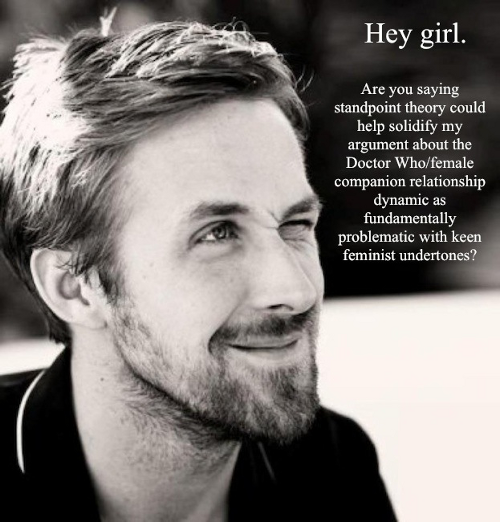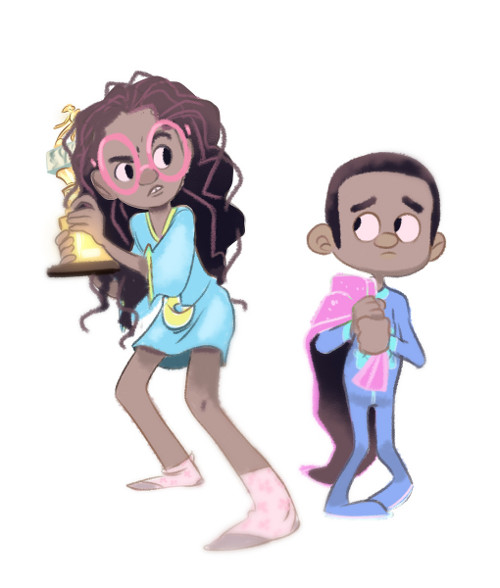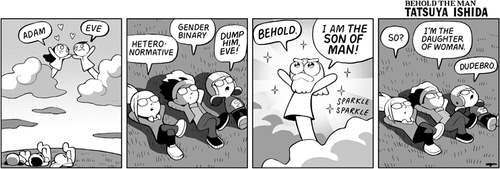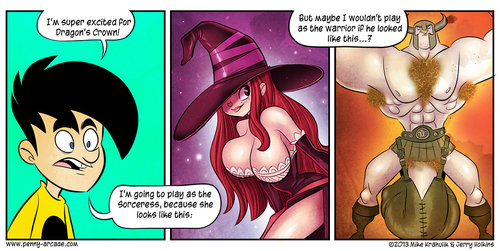
At this most recent CONvergence Con (a sci-fi/fantasy-based convention in Minneapolis, Minn.), I was one of the panelists on two different panels that sought to speak about where and how women can exist in formerly male-dominated genres and spaces.
In The Smurfette Principle in Marketing panel, we tackled the idea that there isn’t often a lot of merchandise available for girls and women because there is often only one woman or girl in a group of men or boys in any given genre show, book, or movie. In the Genre Feminism panel, we spoke about why it was important to increase the visibility of women or girls in a genre show, book, or movie (along with other visible minorities as well) and how people as creators and consumers can promote these ideas.
Specifically to creators, I talked about Geena Davis (whose name I couldn’t remember at the time; apologies, Ms. Davis!) and how back in December 2013, she wrote a guest column for The Hollywood Reporter about how easy it can be for screenwriters to increase the number of roles in film and on TV for women and girls:
Step 1: Go through the projects you’re already working on and change a bunch of the characters’ first names to women’s names. With one stroke you’ve created some colorful unstereotypical female characters that might turn out to be even more interesting now that they’ve had a gender switch. What if the plumber or pilot or construction foreman is a woman? What if the taxi driver or the scheming politician is a woman? What if both police officers that arrive on the scene are women — and it’s not a big deal?
Step 2: When describing a crowd scene, write in the script, “A crowd gathers, which is half female.” That may seem weird, but I promise you, somehow or other on the set that day the crowd will turn out to be 17 percent female otherwise. Maybe first ADs think women don’t gather, I don’t know.
It’s not often that I get to see the fruits of efforts like these so soon after I talk about them, and from a formerly problematic source as well.
Anyone who’s read this blog for any period of time knows I have a love/hate relationship with Penny Arcade creator Mike Krahulik. On one hand, he’s an intensely creative individual who helped pioneer innovations in cartooning, comics, and the marketing thereof. On the other hand, he’s a self-proclaimed asshole who has a lot to learn.
I’m quite pleased to be able to say that after the most recent iteration of the Dickwolves Debacle, the same Mike Krahulik who felt compelled to make a $20,000 donation to the Trevor Project after he made some uneducated remarks about transpeople seems to be also leveling up when it comes to how he depicts characters who aren’t like him in his art.
Recently, Penny Arcade debuted another one of their “one-page worlds.” This one is called Nightlight, and it’s about a first-time father who is told by an Ancient Keeper-type that now that he’s become a parent, he must definitely kill any monsters he finds under his child’s bed.
In his news post for the strip, Krahulik talked about the genesis for the world, but was quick to add: “We’re focusing on Dad’s specifically but honestly the role of a home’s monster hunter can fall to anyone really. I kinda want to meet that big sister.”
Child’s Play community manager Jamie Dillon followed up in the comments to the comic by saying: “We just had a long neat chat about it at lunch, and the world is so cool. Single moms, grandparents, siblings — whomever is the protector of the house is the one who can see the monsters and fight them. I’ll let the guys share other details as they want, but it’s not exclusive to dads.”
But perhaps even better is the news post from Monday, showing that not only are they going to do a longer-form story in this universe, but that Krahulik is taking the time to accurately depict the young girl who will be in this story:

I wanted Grace to feel authentic. I wanted her to be a real little girl and I have zero experience with little girls. I have two boys of my own and more often than not my house is packed with 10 year old boys. Tycho gave me a hard time when I told him about all my Google searching. “They just wear shoes” like everyone else he told me. I know that girls wear shoes…what I don’t know is what kind of shoes Grace wears. Does she wear flip flops? Boots with tights? I don’t know what kinds of outfits she wears. Is she a hoodie and jeans girl or does she like skirts and dresses? I don’t know how she likes to comb her hair or if she wears any jewelry.
The fact that he’s doing this research and thinking this deeply about this character is awesome. In addition to his own spouse as a resource for what young girls are like, he’s also got the experiences of Dillon and Child’s Play project manager Kristin Lindsay, as well as any of the other PA staffers who have female children or nieces or cousins or siblings. He’d be foolish not to tap their resources and experiences.
It’s a little thing, but it’s a start. At the end of this month, I can’t wait to see what kind of Home Protector Grace is for her little brother.


